Zelnik, Zbog and the Gods
Remembering the Recipes that Bind Our Diets to Our Deities
By Chris Christou
 Printable
Version
Printable
Version
In the Old Country, in times that we can no longer sense, there stood
God among the people. For as long as they could remember, the people
had been of that soil, they could remember working it and being worked
by it. While the churches had persisted in the villages since time immemorial,
their prayers' sonic supplications were set over their fields and that
is where they found Him.
The Macedonian word for God is bog, and in the old days the
word for wheat was zbog. Wheat was the accent on the name of
God, the sound that preceded divinity and cradled it among them. Wheat
was their God, the field, their ministry, and the barn their temple.
Throughout the world, there are stories about the enduring and regenerative
matrimony between family and food, between home and harvest, between
the dead and the digested, about how such people, wedded to place, understand
their deities and their diets to be one and the same. This is one of
those stories.
The Flight and The Food
As a child, my sister and I had the great good fortune of being raised,
in part, by our baba and dedo. It was the late 1980s and
our parents were off working themselves to the bone (mostly for us).
This meant that the Old Country tradition of the elders looking after
the youngsters survived the mass migration of the village from western
Macedonia to east Toronto.
My ancestors managed to withstand four centuries of Ottoman rule, but
the collapse of the empire conjured a firestorm in the Balkans whose
ghosts continue to haunt the region. In the first half of the 20th century,
their villages became revolving doors for the occupations of countless
neighbouring armies. The local men were conscripted. Everyone, children
included, was forced to speak a foreign tongue. One of my babas remembers
the policemen, pressed against the family's house at night, listening
in for any whisper of Macedonian, a crime whose punishment included
flogging, jail time or being tied to a post for days on end in the town
square. In the 1950s, as the ashes of war began to settle, the borders
between communist Yugoslavia and fascist Greece were set to be petrified
with barbed-wire fences, right down the middle of the lands my extended
kin inhabited. ‘Choose,' they were told. Not unsurprisingly, like so
many in the region, they left, rarely if ever speaking of these things
in our presence.
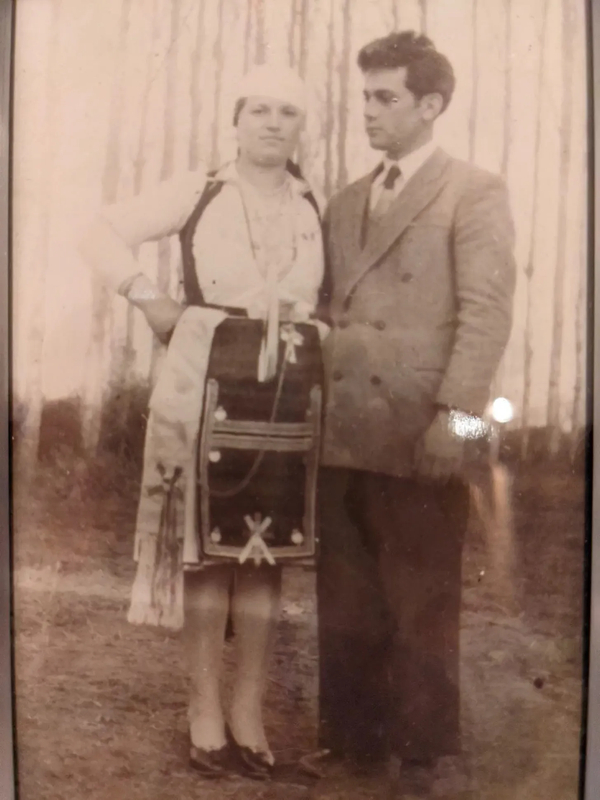
My baba and detho on their wedding day. Somewhere in Aegean Macedonia,
circa 1950.
We were blessed in that way, for a time. But not everything survives
exile, and usually it is the memory of migration that's the first to
go. In its place, we often find the gastronomy of a people, cultivating
and sometimes hospicing the remnants of culture. My family was no exception.
Arriving in Canada in the 1960s, many of the ex-villagers began working
in restaurants, a typical tour-de-force for recent immigrants. Fresh-off-the
boat often means right-into-the-kitchen, and, for those who can afford
it, into one that can maintain the village hearth and hospitality as
a means of survival. To thrive in a new, alien and often hostile world,
people utilise what they know, and for many that includes the indelible
and ancestral recipes they secretly stash away and smuggle through customs.
While my family never opened a Macedonian restaurant, the Old Country
aromas and flavours flowed through their kitchens. Their recipes were
resurrected in the New World, feeding the umbilical cord of memory that
connected there and here, then and now, us and them.
Our Spiral Sustenance
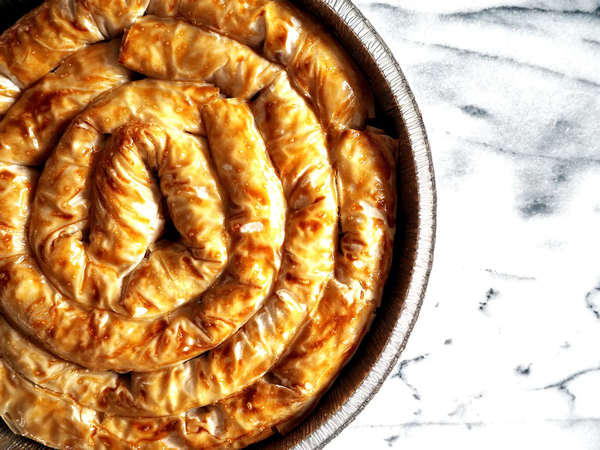
Among all of our baba's dishes, there was one that was sacred. Zelnik,
they called it. In the Old Country, our people only prepared it for
special occasions, which usually meant saints' days, baptisms, weddings
and funerals. As in many cultures, certain foods are reserved resolutely
for ceremony as the sustaining, ritual reminders of life's cyclic celebrations.
To put it another way, the appearance of specific foods, like the appearance
of certain dates, the changes in the weather and the shape of the village,
signify the perpetuation and vitality of ceremony. It is ushered in
through the kitchen as it is in the fields, as people sow and reap,
as they mix and mould the sustaining bounty of their soils. If there
is no field and no farming, what becomes of the ceremony?
If there is no ceremony, what becomes of the dish, of the diet, and
of the deities?
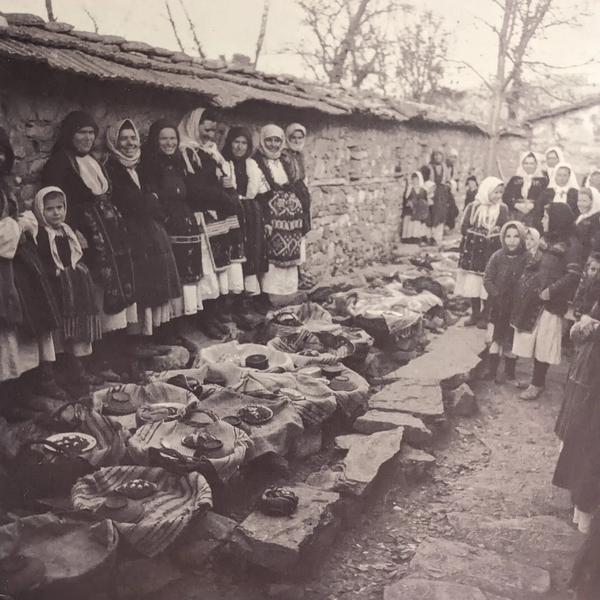 Macedonian
peasants preparing for a meal.
Macedonian
peasants preparing for a meal.
As a child in Toronto, zelnik quickly became my favourite food, and
our baba would make it as much as she could whenever we were around.
Removed from the place her people knew as the centre of the world for
as long as they could remember, we became the occasion for ceremony
in her days. She, like many of her sisters, aunts and babas, were the
guardians of hearth, hospitality and memory. They, the arches of the
familial and communal thresholds, ensured that their ceremonies would
persist in exile. From morning till afternoon, she spent hours spreading
out the skin thin layers of hand-formed phyllo dough, painting them
with butter and egg wash, and filling their innards with brined cheese
and sometimes spinach. She would then carefully fold the dough into
long serpentine rolls and coil each one around itself until it took
the shape of a spiral. These hand-woven, wheaten prayers were then left
to Grandfather Fire to bake, and if well-wrought such a petition would
provoke a golden sheen on the surface, signalling the birth of another
zelnik.
During our New Year's gatherings, the babas observed an ancient tradition
related to St. Basil. They would hide a coin in the zelnik, then carefully
cut the spiral into small sections, ensuring everyone had a piece. Whoever
received the auspicious slice would be blessed with good luck (and often
money) for the following year, a small manifestation of the family's
continued fortune.
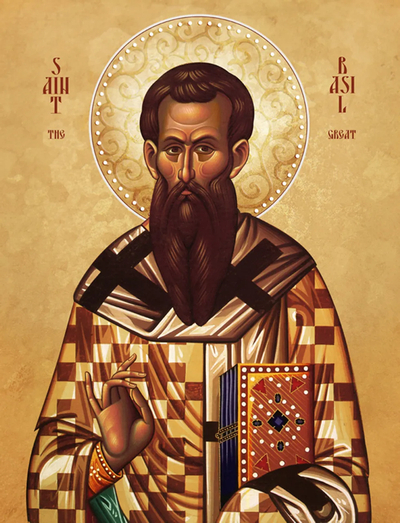
St. Basil
For my people, as for many others, zelnik was a cornerstone of immigrant
identity, the breadcrumbs of memory laid down like pathways by the ancestors.
They are also often the last thing to disappear from that path after
the newcomers shorten their names, cast off their mother tongues, after
they trade in their traditional clothing for department store bargains,
their craft traditions for office jobs, their dances and rituals for
modern rites, and their myths for history.
However, when still stewarded, a people's foodways can root a sense
of identity. This is what zelnik did for me. It was ours. It
belonged to us and staked a claim as something that made us Macedonian.
It offered a quintessential connection to an ancestral homeland, to
culture, and to the dead. But as it turned out, zelnik is part of a
looping lineage that can pry us from the pitfalls of ethnicity and nationality,
of the overzealous identification with the ‘I' that often arrives with
the seductive satisfaction of knowing my heritage, my
history, and my culture. The majesty and mystery of food is that
it is never for you and never has been.
The Subversion of a Singular Identity
After our baba's death, I slowly forgot about her cooking, tasting
less and less of it as the years went by. Recently, however, alone in
my apartment, I was stopped dead in my tracks by the overwhelming aroma
of her freshly baked zelnik.
The ancient odour prompted a web search. Not unsurprisingly, what arose
was a litany of mouth-watering photos. One of them popped up with a
location attached. It was a restaurant in Turkey. ‘Wow, they have zelnik
in Turkey?' I thought. Then I found a cookbook online with a zelnik
recipe in it, but there was no section on Macedonia. The recipe was
in the Ukraine chapter. Later on, while hanging out with a Bulgarian
friend, I mentioned zelnik and described it to her. ‘Oh, that's burek,'
she responded. As it turns out, the Turks, the Greeks, the Romanians
and almost every other people in the Ottoman-influenced region have
their own name (and version) of zelnik. In some cultures, for example,
there is no spiral pattern baked into the bread.
The story's roots expand as they deepen. Before my family emigrated
to Canada, before incessant wars and cultural genocide came upon them
in the Old Country, Ottoman control spanned North Africa to the Persian
Gulf to the Balkans and everything in between. For half a millennium,
colonial trade and travel persisted under a system of relative religious
freedom (between Muslims, Christians and Jews) and this ensured a veritable
kneading of the cultural grain.
The roots of the word burek, zelnik's better-known sibling, come from
the Turkish borek, meaning ‘stew'1.
Like mole in Mexico and curry in South Asia, these names commonly
refer to a plurality of flavours, of many seeds and roots. While the
etymology of burek stretches back to ancient Persia, the origin of the
recipe itself is unclear. Some claim that it arrived from Central Asia
by way of Turkic nomads, some consider it a dish of the Ottoman high
court, while others see a link to Byzantine times.
Like its Aegean and Anatolian analogues, zelnik was a colonial dish,
one that became indigenous to each of those places over time. The people
honoured their manner of being in and of place by ensuring that their
own local, cultural and ceremonial ingredients were pressed into the
dough. Their maker's mark, in other words. Zelnik is as Macedonian as
burek is Bulgarian as placinta dobrogeana is Romanian, all of
which are inherited through colonisation. This is to say that sometimes
they don't belong to a single people. Burek is also the national dish
of the Macedonian state. By planting the dish in the local terroir,
each community plunged their roots into the assimilating ground of empire.
Each provides a path towards restoring ancestral memory, and subsequently
remembering how it is forgotten.
I'm reminded of the words of a friend and elder, the culture activist,
author and grief-worker Stephen Jenkinson: ‘The enemy of my ancestor
is also my ancestor'. The nuances in my people's traditional dress,
in their architecture and dance, even in my own appearance, are all
consequences of the conquest, fusion and confusion that arises. Just
like zelnik. The wars, the persecution, the migration, the ceremonies,
the celebration and the love. Every ingredient is added. All of it.
Cradled and cooked, it is nourishment and memory. All are eaten and
all are fed, and in this way we begin to undo that enmity, piece by
piece.
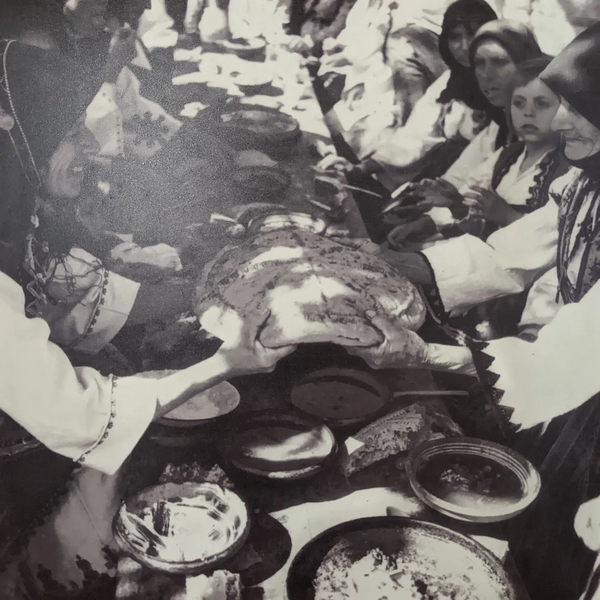 Two
Macedonian peasant families breaking bread.
Two
Macedonian peasant families breaking bread.
A Moveable Feast, A Migratory Famine
Years ago, I landed on the semi-desert shores of Oaxaca, Mexico. I
was lucky enough to begin an apprenticeship with culture, with what
it revealed and what it concealed. In the markets, at the molinos,
in the bowls and on the plates of the people, one can peer into the
bubbles in the bread and beverages to know something more of place and
time. My attention led me to an old understanding, one contained and
carried throughout many parts of the world.
In certain cultures of southern Mexico, cacao and maize are still remembered
as deities. Depending on where and when you are, the names, forms and
functions can be distinct, but they are almost always divine and personified
as such. While being worshipped as gods, cacao and maize are also known
as ancestors – the first ancestors – of human beings in Mesoamerica.
In the Popol Vuh, the Quiche Maya creation story, the first fathers
are both made of maize and subsequently fed it in order to become fully
human.
The Quiche are not alone. Countless cultures held and hold their principal
foods, their staple crops, and the animals they husband as ancestors.
One Hunahpu (maize) in the Mayan world, Dionysus (wine)
in Greece, Inari (rice) in Shinto Japan, Axomamma (potato)
for the Inca, Heryshaf (sheep) in Egypt, and Maxayuawi
(deer) for the Wixarika. Zbog (wheat) for the Macedonians.
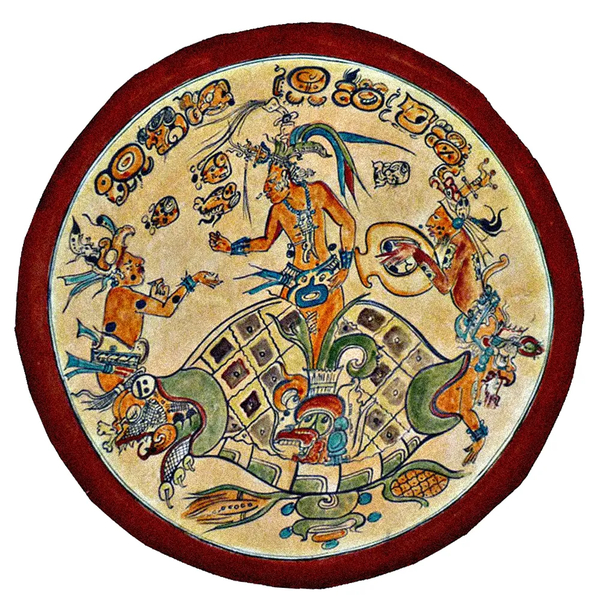 Scene
from the Popol Vuh in which the Hero Twins reincarnate their uncle as
the Maize God.
Scene
from the Popol Vuh in which the Hero Twins reincarnate their uncle as
the Maize God.
When we honour ancestry, we feed the divine among us. When we understand
the animals and plants we eat as primordial ancestors, we can begin
to coax from the crumbs what it means to commune together, what it means
to be nourished by the dead and the divine, and what it means to be
descendants of each.
Zelnik is an example of how the enemy of my ancestors is also my ancestor,
how each of them, mostly by virtue of being born into their circumstances,
are folded into the sustenance that fed my family long enough so I could
be here today, writing this for you. Odds are that the stories are not
all that different among your people.
Traditional food and drink are not representations of lineage. They
are not symbols of ancestry. They are ancestry. In some cases,
the foods themselves are the bodies and blood of ancestors transformed,
moulded by descendant hands to remake and remember the ancient relationships
between the living and the dead who sustain them. In other cases, the
foods themselves are the guests of honour, the occasion for the ceremony,
the living memory of the sustenance that kept your people alive long
enough so you could be reading this today.
To understand what is hidden in our nourishment is to know what we've
allowed to go unfed, and whom. To deny the inherent diversity in ancestry
because it doesn't suit your politics or morals is to make a monocultural
Monsanto field of memory. It is to reproduce what made your people conquerors
or conquered in the first place. It is to consume instead of commune.
It is to only ever ask what you are eating and never whom.
Today, many of the fields surrounding the villages in western Macedonia,
like the fields surrounding my home in Oaxaca, are examples of such
amnesia. The Gods of Wheat, like the Gods of Maize, have become relics,
reconstituted as alimentary fuel pumps, nutrition sources and natural
resources, served by supermarkets, biotech companies and emigration.
Similarly, the people of Oaxaca are the inheritors of centuries of brutal
conquest, of cultural genocide and exile. The American dream – or nightmare
– tempts villagers into the cities, slowly emptying the countryside,
uprooting the food-borne relationships that blend together the living,
the dead and the divine into masa, the dough of community.
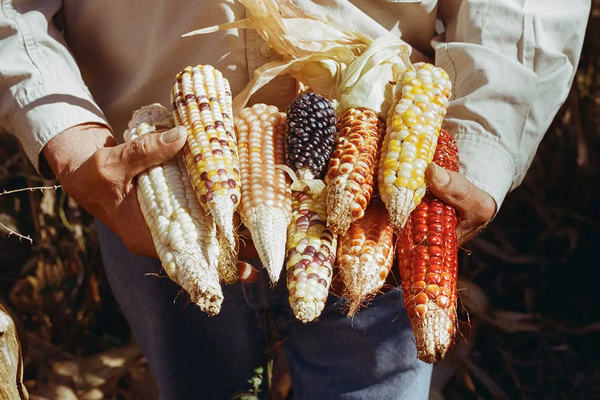 A
Mexican peasant farmer carrying his heriloom corn/ maize.
A
Mexican peasant farmer carrying his heriloom corn/ maize.
After a day's work in the jungle, I'm often invited into my compañeros'
homes, offered their ancestral hospitality, fortified and inspirited
by their grandmothers' criollo tortillas. I witness first-hand
the often dire dilemmas visiting their villages and all at once am transported
to my baba and dedo's, a century ago. I wonder if the spiral zelnik
and the lunar tortilla aren't both anointed tutors of time, holy reminders
of resilience and relationship, constantly at risk of slipping from
view.
In the few feasts and fields in which these ancestors are still kept
alive, nourishment arrives as memory – the collective memory that we
are fed and entered into. Communing with the millennia-old lineages
tying people to place and food, we are braided into that double-helixed
digestion with each bite. What it might offer us is medicine, food for
our times: that the lineage of sustenance continues to be forged not
because the people in question were your ancestors, not because of what
the food is, but who it is.
This is the recipe that my baba inherited, and that she has left to
us. These are the ingredients of zelnik, the divine harvest of a people.
When these things coalesce, ceremony can begin. When they are forgotten,
the world is famished.
This is the food.
This is the grace.
1. It is important
to remember that recipes, like words, have many versions, histories,
and lives. Here is another root of borek: "According to the Austrian
Turcologist, Andrea Tietze, ‘börek' comes from the Persian ‘bûrak',
which referred to any dish made with yufka. This, in turn, probably
came from the Turkic root, bur-, meaning ‘to twist' – an allusion
to the way thin sheets of dough had to be manipulated to produce a layered
effect." #
Originally Published in Dark Mountain Issue #23 - Dark Kitchen (2023).
You can purchase a copy and read the other written fermentations here.
Chris Christou is a culture activist, writer, and podcaster. See http://www.chrischristou.net
January 2024
Copyright
Source: www.pollitecon.com

